Multiaxial Deformations of Elastomeric Skins for Morphing Wing Applications: Theoretical Modeling and Experimental Investigations
Abstract
1. Introduction
2. Experimental
2.1. Experimental Set Up
2.2. Specimen Geometry, Elastomer Synthesis, and Experimental Conditions
2.3. Various Mechanical Tests under Multiaxial Modes of Deformation
2.4. Strain Measurement under Various Modes of Deformations
3. Material Modeling
3.1. Kinematics of Hyperelastic Deformation
3.2. Governing Equations of Hyperelastic Deformation
3.2.1. Uniaxial Mode of Deformation
3.2.2. Pure Shear Mode of Deformation
3.2.3. Biaxial Mode of Deformation
3.2.4. Equibiaxial Mode of Deformation
3.3. A Newly Proposed Material Model
4. Results and Discussions
4.1. Identification of Material Parameters
4.2. Mechanical Comparison of Latex, Oppo, and Ecoflex Elastomers
5. Concluding Remarks
Author Contributions
Funding
Institutional Review Board Statement
Informed Consent Statement
Data Availability Statement
Conflicts of Interest
References
- Barbarino, S.; Bilgen, O.; Ajaj, R.M.; Friswell, M.I.; Inman, D.J. A review of morphing aircraft. J. Intell. Mater. Syst. Struct. 2011, 22, 823–877. [Google Scholar] [CrossRef]
- Harvey, C.; Gamble, L.L.; Bolander, C.R.; Hunsaker, D.F.; Joo, J.J.; Inman, D.J. A review of avian-inspired morphing for UAV flight control. Prog. Aerosp. Sci. 2022, 132, 100825. [Google Scholar] [CrossRef]
- Li, D.; Zhao, S.; Da Ronch, A.; Xiang, J.; Drofelnik, J.; Li, Y.; Zhang, L.; Wu, Y.; Kintscher, M.; Monner, H.P.; et al. A review of modelling and analysis of morphing wings. Prog. Aerosp. Sci. 2018, 100, 46–62. [Google Scholar] [CrossRef]
- Ajaj, R.M.; Friswell, M.I. Aeroelasticity of compliant span morphing wings. Smart Mater. Struct. 2018, 27, 105052. [Google Scholar] [CrossRef]
- Keihl, M.M.; Bortolin, R.S.; Sanders, B.; Joshi, S.; Tidwell, Z. Mechanical properties of shape memory polymers for morphing aircraft applications. In Smart Structures and Materials 2005: Industrial and Commercial Applications of Smart Structures Technologies; SPIE: Bellingham, WA, USA, 2005; Volume 5762, p. 143. [Google Scholar]
- Xiao, L.; Zhao, H.; Xu, Z.; Li, X.; Shen, C.; Wang, K.; Zhang, L. A New Architecture of Morphing Wing Based on Hyperelastic Materials and Metastructures with Tunable Stiffness. Front. Mech. Eng. 2022, 7, 112. [Google Scholar] [CrossRef]
- Sun, J.; Du, L.; Scarpa, F.; Liu, Y.; Leng, J. Morphing wingtip structure based on active inflatable honeycomb and shape memory polymer composite skin: A conceptual work. Aerosp. Sci. Technol. 2021, 111, 106541. [Google Scholar] [CrossRef]
- Ajaj, R.M.; Parancheerivilakkathil, M.S.; Amoozgar, M. Asapp: A polymorphing wing capable of active span extension and passive pitch. In Proceedings of the AIAA Scitech 2021 Forum, Virtual Event, 11–15 & 19–21 January 2021; pp. 1–19. [Google Scholar]
- Ajaj, R.M.; Parancheerivilakkathil, M.S.; Amoozgar, M.; Friswell, M.I.; Cantwell, W.J. Recent developments in the aeroelasticity of morphing aircraft. Prog. Aerosp. Sci. 2021, 120, 100682. [Google Scholar] [CrossRef]
- Kikuta, M.T. Mechanical Properties of Candidate Materials for Morphing Wings. Ph.D. Thesis, Virginia Tech, Blacksburg, VA, USA, 2003. [Google Scholar]
- Thill, C.; Etches, J.; Bond, I.; Potter, K.; Weaver, P. Morphing skins. Aeronaut. J. 2008, 112, 117–139. [Google Scholar] [CrossRef]
- Peel, L.D.; Mejia, J.; Narvaez, B.; Thompson, K.; Lingala, M. Development of a simple morphing wing using elastomeric composites as skins and actuators. J. Mech. Des. Trans. ASME 2009, 131, 0910031–0910038. [Google Scholar] [CrossRef]
- Bishay, P.L.; Aguilar, C. Parametric study of a composite skin for a twist-morphing wing. Aerospace 2021, 8, 259. [Google Scholar] [CrossRef]
- Bubert, E.A.; Woods, B.K.; Lee, K.; Kothera, C.S.; Wereley, N.M. Design and fabrication of a passive 1D morphing aircraft skin. J. Intell. Mater. Syst. Struct. 2010, 21, 1699–1717. [Google Scholar] [CrossRef]
- Ajaj, R.M.; Flores, E.I.S.; Friswell, M.I.; Allegri, G.; Woods, B.K.S.; Isikveren, A.T.; Dettmer, W.G. The Zigzag wingbox for a span morphing wing. Aerosp. Sci. Technol. 2013, 28, 364–375. [Google Scholar] [CrossRef]
- Olympio, K.R.; Gandhi, F. Zero poisson’s ratio cellular honeycombs for flex skins undergoing one-dimensional morphing. J. Intell. Mater. Syst. Struct. 2010, 21, 1737–1753. [Google Scholar] [CrossRef]
- Olympio, K.R.; Gandhi, F. Flexible skins for morphing aircraft using cellular honeycomb cores. J. Intell. Mater. Syst. Struct. 2010, 21, 1719–1735. [Google Scholar] [CrossRef]
- Olympio, K.R.; Gandhi, F.; Asheghian, L.; Kudva, J. Design of a flexible skin for a shear morphing wing. J. Intell. Mater. Syst. Struct. 2010, 21, 1755–1770. [Google Scholar] [CrossRef]
- Woods, B.K.S.; Friswell, M.I. The adaptive aspect ratio morphing wing: Design concept and low fidelity skin optimization. In Proceedings of the ASME 2014 Conference on Smart Materials, Adaptive Structures and Intelligent Systems, SMASIS 2014, Newport, RI, USA, 8–10 September 2014. [Google Scholar]
- Woods, B.K.S.; Heeb, R.M. Design principles for geometrically anisotropic thermoplastic rubber morphing aircraft skins. J. Intell. Mater. Syst. Struct. 2022, 1–18. [Google Scholar] [CrossRef]
- Rivero, A.E.; Fournier, S.; Heeb, R.M.; Woods, B.K. Design, Manufacture and Wind Tunnel Test of a Modular FishBAC Wing with Novel 3D Printed Skins. Appl. Sci. 2022, 12, 652. [Google Scholar] [CrossRef]
- Parancheerivilakkathil, M.S.; Ajaj, R.M.; Khan, K.A. A compliant polymorphing wing for small UAVs. Chin. J. Aeronaut. 2015, 33, 2575–2588. [Google Scholar] [CrossRef]
- Hossain, M.; Vu, D.K.; Steinmann, P. Experimental study and numerical modelling of VHB 4910 polymer. Comput. Mater. Sci. 2012, 59, 65–74. [Google Scholar] [CrossRef]
- Hossain, M.; Liao, Z. An additively manufactured silicone polymer: Thermo-viscoelastic experimental study and computational modelling. Addit. Manuf. 2020, 35, 101395. [Google Scholar] [CrossRef]
- Liao, Z.; Hossain, M.; Yao, X. Ecoflex polymer of different Shore hardnesses: Experimental investigations and constitutive modelling. Mech. Mater. 2020, 144, 103366. [Google Scholar] [CrossRef]
- Bergstrom, J.S. Constitutive Modeling of the Large Strain Time-Dependent Behaviour of Elastomers. J. Mech. Phys. Solids 1998, 46, 931–954. [Google Scholar] [CrossRef]
- Treloar, L.R. The mechanics of rubber elasticity. J. Polym. Sci. Polym. Symp. 1974, 48, 107–123. [Google Scholar] [CrossRef]
- Steinmann, P.; Hossain, M.; Possart, G. Hyperelastic models for rubber-like materials: Consistent tangent operators and suitability for Treloar’s data. Arch. Appl. Mech. 2012, 82, 1183–1217. [Google Scholar] [CrossRef]
- Hossain, M.; Steinmann, P. More hyperelastic models for rubber-like materials: Consistent tangent operators and comparative study. J. Mech. Behav. Mater. 2012, 22, 27–50. [Google Scholar] [CrossRef]
- Schmidt, A.; Rothemund, P.; Mazza, E. Multiaxial deformation and failure of acrylic elastomer membranes. Sens. Actuators A Phys. 2012, 174, 133–138. [Google Scholar] [CrossRef]
- Ahmad, D.; Sahu, S.K.; Patra, K. Fracture toughness, hysteresis and stretchability of dielectric elastomers under equibiaxial and biaxial loading. Polym. Test. 2019, 79, 106038. [Google Scholar] [CrossRef]
- Horgan, C.O. The remarkable Gent constitutive model for hyperelastic materials. Int. J. Non-Linear Mech. 2015, 68, 9–16. [Google Scholar] [CrossRef]
- Guo, Z.; Sluys, L.J. Application of a new constitutive model for the description of rubber-like materials under monotonic loading. Int. J. Solids Struct. 2006, 43, 2799–2819. [Google Scholar] [CrossRef]
- Dal, H.; Açıkgöz, K.; Badienia, Y. On the performance of isotropic hyperelastic constitutive models for rubber-like materials: A state of the art review. Appl. Mech. Rev. 2021, 73, 020802. [Google Scholar] [CrossRef]
- Ogden, R.W. Large Deformation Isotropic Elasticity—On the Correlation of Theory and Experiment for Incompressible Rubberlike Solids. Proc. R. Soc. A Math. Phys. Eng. Sci. 1972, 326, 565–584. [Google Scholar] [CrossRef]
- Khajehsaeid, H.; Arghavani, J.; Naghdabadi, R. A hyperelastic constitutive model for rubber-like materials. Eur. J. Mech.-A/Solids 2013, 38, 144–151. [Google Scholar] [CrossRef]
- Carroll, M. A strain energy function for vulcanized rubbers. J. Elast. 2011, 103, 173–187. [Google Scholar] [CrossRef]
- Ahmad, D.; Ajaj, R.M. Multiaxial mechanical characterization of latex skin for morphing wing application. Polym. Test. 2021, 106, 107408. [Google Scholar] [CrossRef]
- Helal, A.; Doumit, M.; Shaheen, R. Biaxial experimental and analytical characterization of a dielectric elastomer. Appl. Phys. A 2018, 124, 2. [Google Scholar] [CrossRef]
- Ahmad, D.; Ajaj, R.M.; Amoozgar, M. Elastomer-based skins for morphing aircraft applications: Effect of biaxial strain rates and prestretch. Polym. Test. 2022, 113, 107655. [Google Scholar] [CrossRef]
- Pharr, M.; Sun, J.Y.; Suo, Z. Rupture of a highly stretchable acrylic dielectric elastomer. J. Appl. Phys. 2012, 111, 104114. [Google Scholar] [CrossRef]
- Kaltseis, R.; Keplinger, C.; Adrian Koh, S.J.; Baumgartner, R.; Goh, Y.F.; Ng, W.H.; Kogler, A.; Tröls, A.; Foo, C.C.; Suo, Z.; et al. Natural rubber for sustainable high-power electrical energy generation. RSC Adv. 2014, 4, 27905–27913. [Google Scholar] [CrossRef]
- Ahmad, D.; Patra, K. Experimental and theoretical analysis of laterally pre-stretched pure shear deformation of dielectric elastomer. Polym. Test. 2019, 75, 291–297. [Google Scholar] [CrossRef]
- Dal, H.; Gültekin, O.; Açıkgöz, K. An extended eight-chain model for hyperelastic and finite viscoelastic response of rubberlike materials: Theory, experiments and numerical aspects. J. Mech. Phys. Solids 2020, 145, 104159. [Google Scholar] [CrossRef]
- Reuge, N.; Schmidt, F.; Le Maoult, Y.; Rachik, M.; Abbé, F. Elastomer biaxial characterization using bubble inflation technique. I: Experimental investigations. Polym. Eng. Sci. 2001, 41, 522–531. [Google Scholar] [CrossRef]
- Bonet, J.; Wood, R.D. Nonlinear Continuum Mechanics for Finite Element Analysis; Cambridge University Press: Cambridge, UK, 1997. [Google Scholar]
- Bowen, R.M.; Wang, C.C. Introduction to Vectors and Tensors. 2. Vector and Tensor Analysis; Plenum Press: New York, NY, USA, 1976. [Google Scholar]
- Ogden, R.; Sternberg, E. Nonlinear Elastic Deformations; Courier Corporation: North Chelmsford, MA, USA, 1985. [Google Scholar]
- Beatty, M.F. Topics in finite elasticity: Hyperelasticity of rubber, elastomers, and biological tissues—With examples. Appl. Mech. Rev. 1987, 40, 1699–1734. [Google Scholar] [CrossRef]
- Rivlin, R.S.; Saunders, D. Large elastic deformations of isotropic materials VII. Experiments on the deformation of rubber. Philos. Trans. R. Soc. Lond. Ser. A Math. Phys. Sci. 1951, 243, 251–288. [Google Scholar]
- Külcü, İ.D. A hyperelastic constitutive model for rubber-like materials. Arch. Appl. Mech. 2020, 90, 615–622. [Google Scholar] [CrossRef]
- Ahmad, D.; Patra, K.; Hossain, M. Experimental study and phenomenological modelling of flaw sensitivity of two polymers used as dielectric elastomers. Contin. Mech. Thermodyn. 2019, 32, 489–500. [Google Scholar] [CrossRef]
- Ahmad, D.; Patra, K.; Hossain, M.; Kumar, A. Crack propagation behaviour of laterally constrained polymers used as dielectric elastomers. Rubber Chem. Technol. 2021, 94, 476–493. [Google Scholar] [CrossRef]
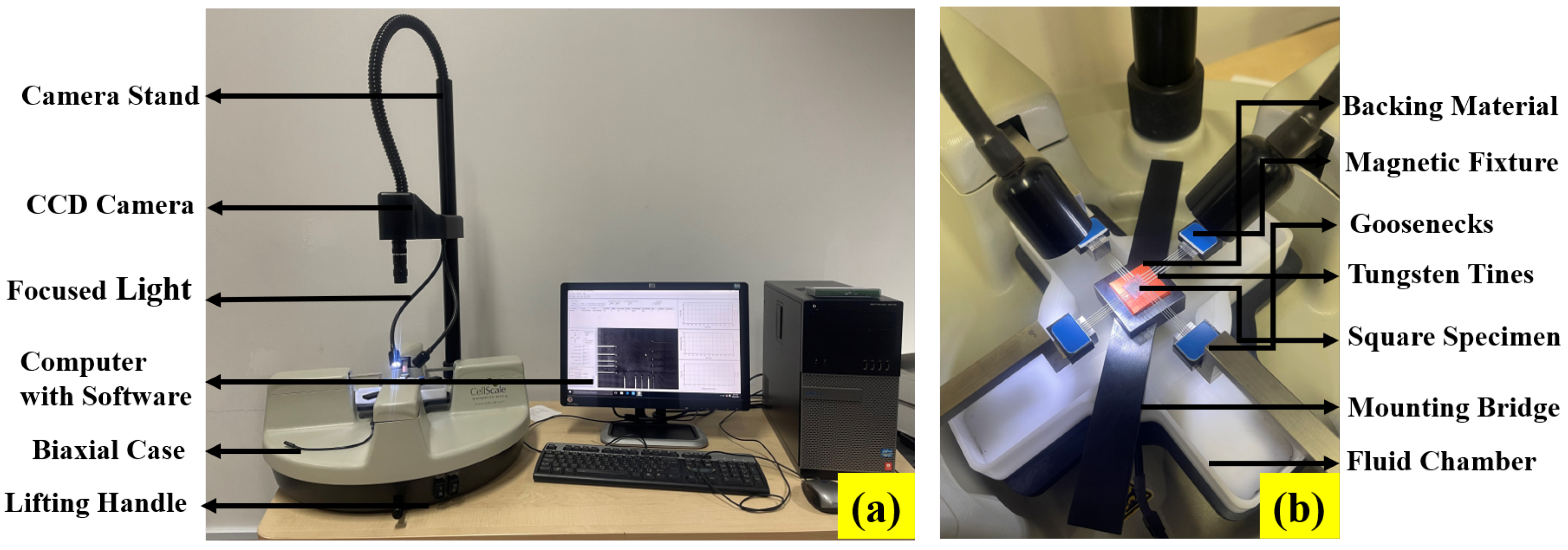

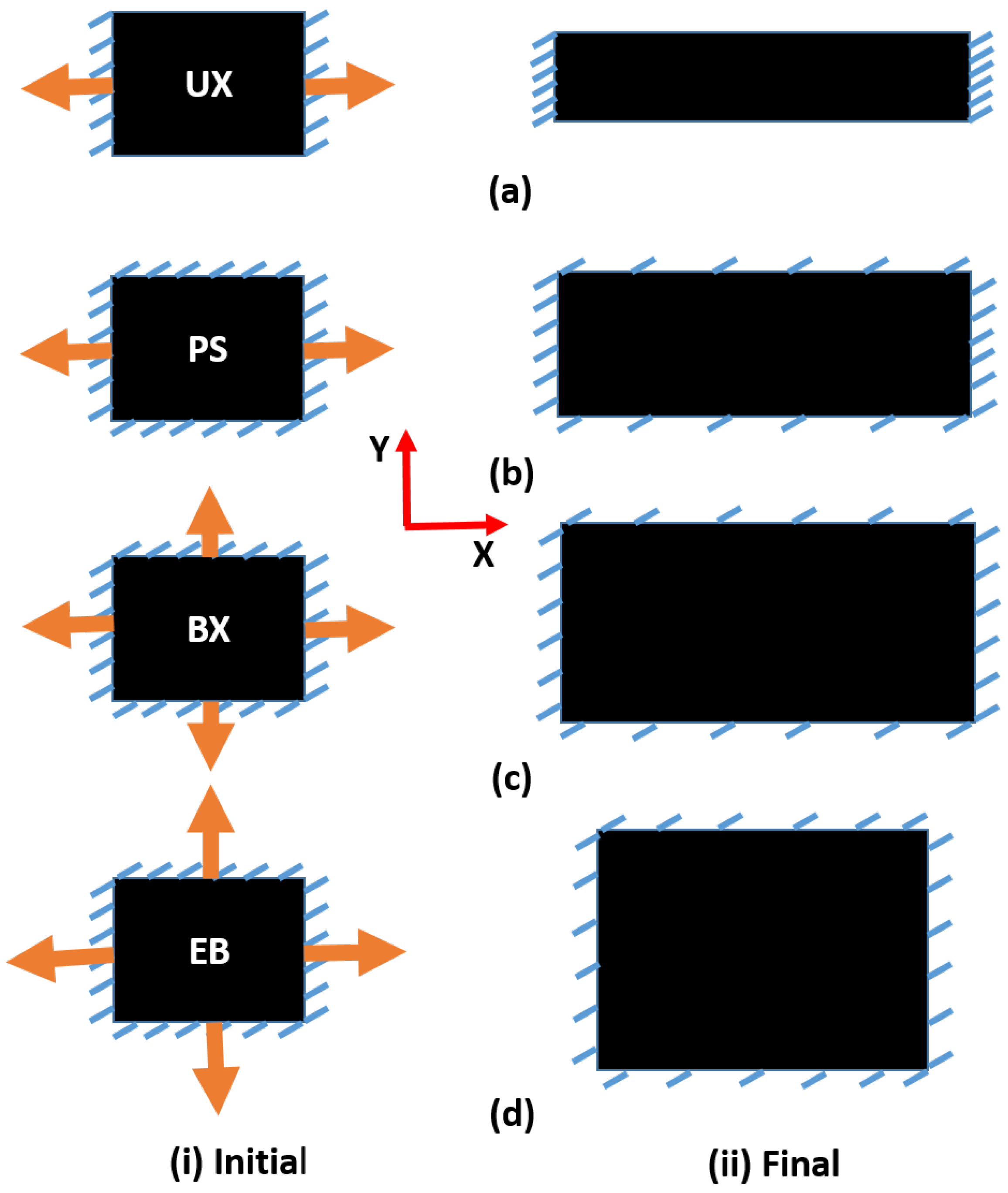
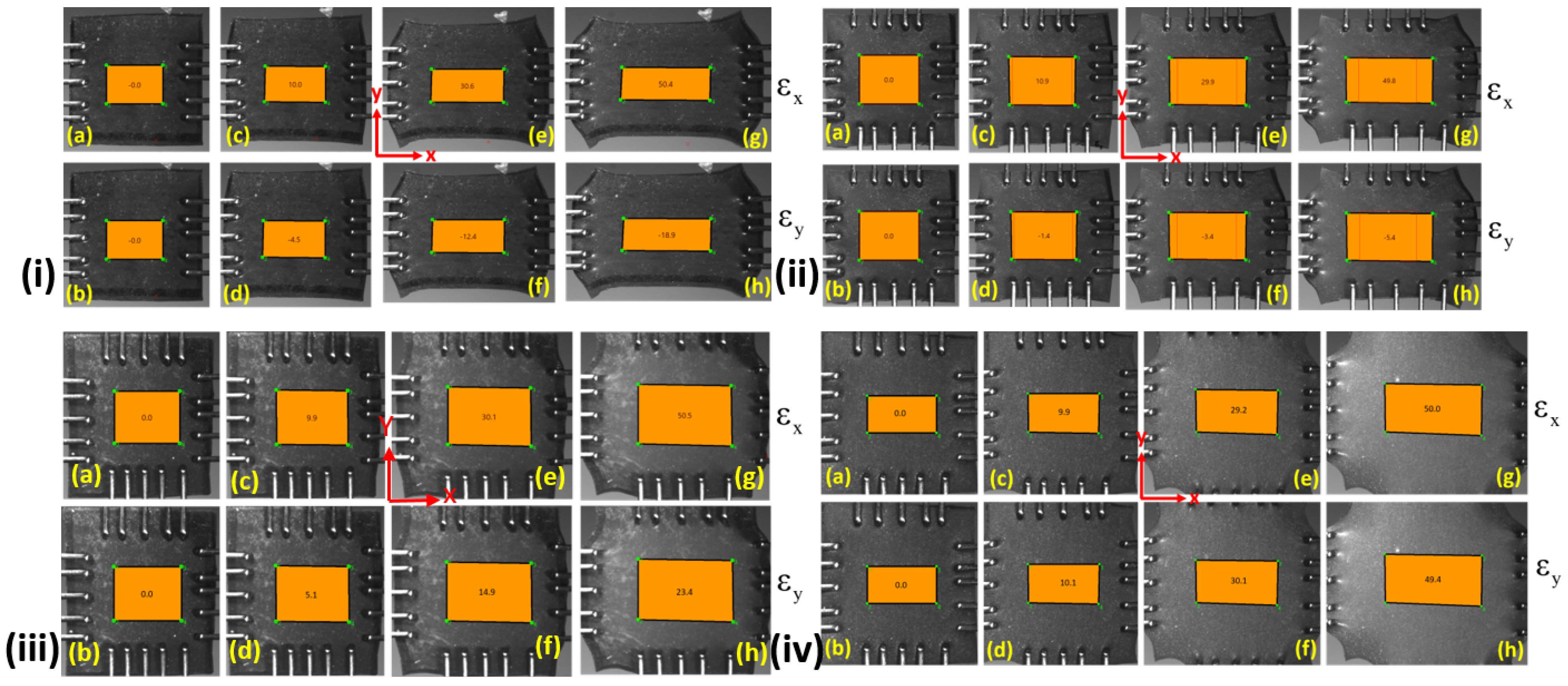

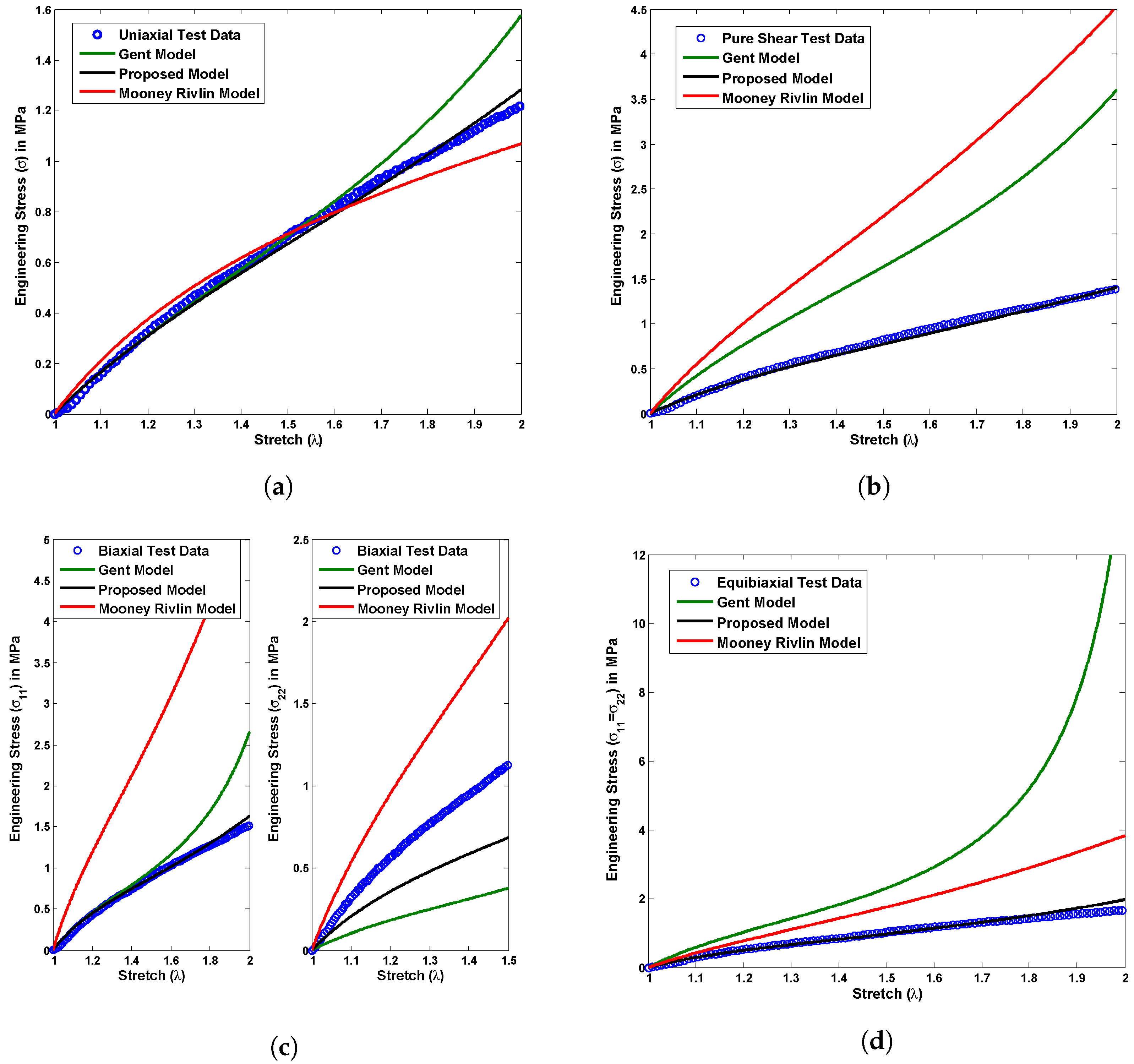
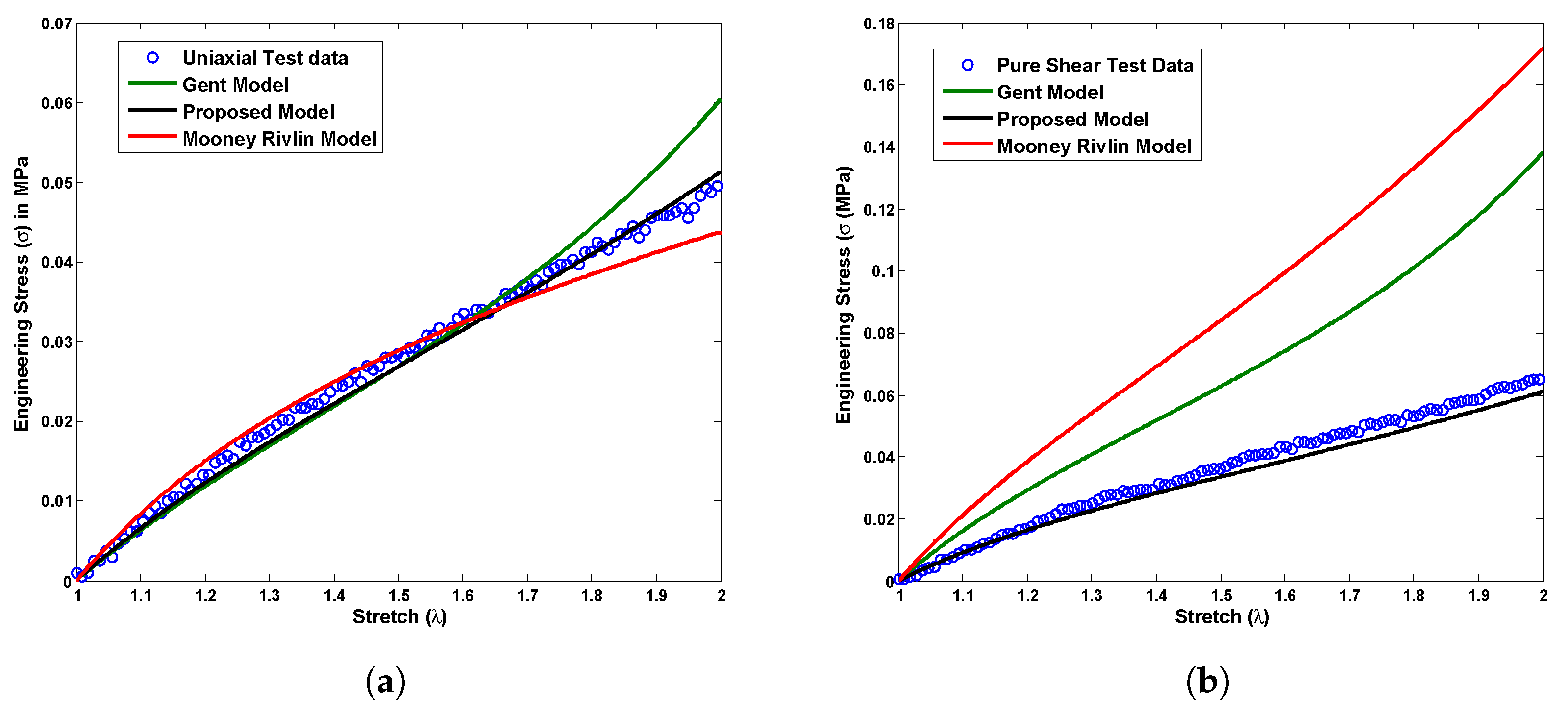
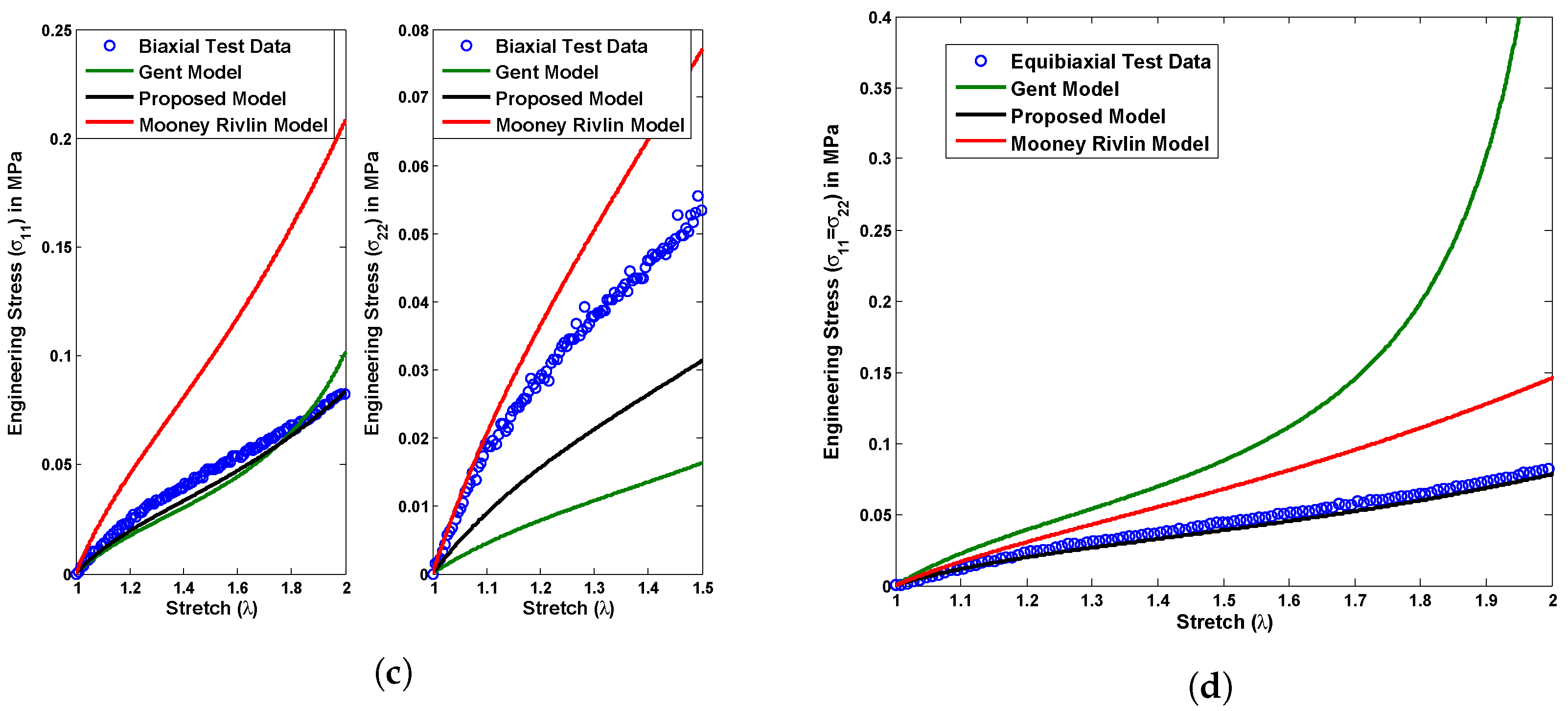
| Constitutive Model | Material Constants |
|---|---|
| Proposed model | MPa, , , |
| Mooney Rivlin model | MPa, MPa |
| Gent model | MPa, |
| Constitutive Model | Material Constants |
|---|---|
| Proposed model | MPa, , , |
| Mooney Rivlin model | MPa, MPa |
| Gent model | MPa, |
Publisher’s Note: MDPI stays neutral with regard to jurisdictional claims in published maps and institutional affiliations. |
© 2022 by the authors. Licensee MDPI, Basel, Switzerland. This article is an open access article distributed under the terms and conditions of the Creative Commons Attribution (CC BY) license (https://creativecommons.org/licenses/by/4.0/).
Share and Cite
Ahmad, D.; Kumar, D.; Ajaj, R.M. Multiaxial Deformations of Elastomeric Skins for Morphing Wing Applications: Theoretical Modeling and Experimental Investigations. Polymers 2022, 14, 4891. https://doi.org/10.3390/polym14224891
Ahmad D, Kumar D, Ajaj RM. Multiaxial Deformations of Elastomeric Skins for Morphing Wing Applications: Theoretical Modeling and Experimental Investigations. Polymers. 2022; 14(22):4891. https://doi.org/10.3390/polym14224891
Chicago/Turabian StyleAhmad, Dilshad, Deepak Kumar, and Rafic M. Ajaj. 2022. "Multiaxial Deformations of Elastomeric Skins for Morphing Wing Applications: Theoretical Modeling and Experimental Investigations" Polymers 14, no. 22: 4891. https://doi.org/10.3390/polym14224891
APA StyleAhmad, D., Kumar, D., & Ajaj, R. M. (2022). Multiaxial Deformations of Elastomeric Skins for Morphing Wing Applications: Theoretical Modeling and Experimental Investigations. Polymers, 14(22), 4891. https://doi.org/10.3390/polym14224891








